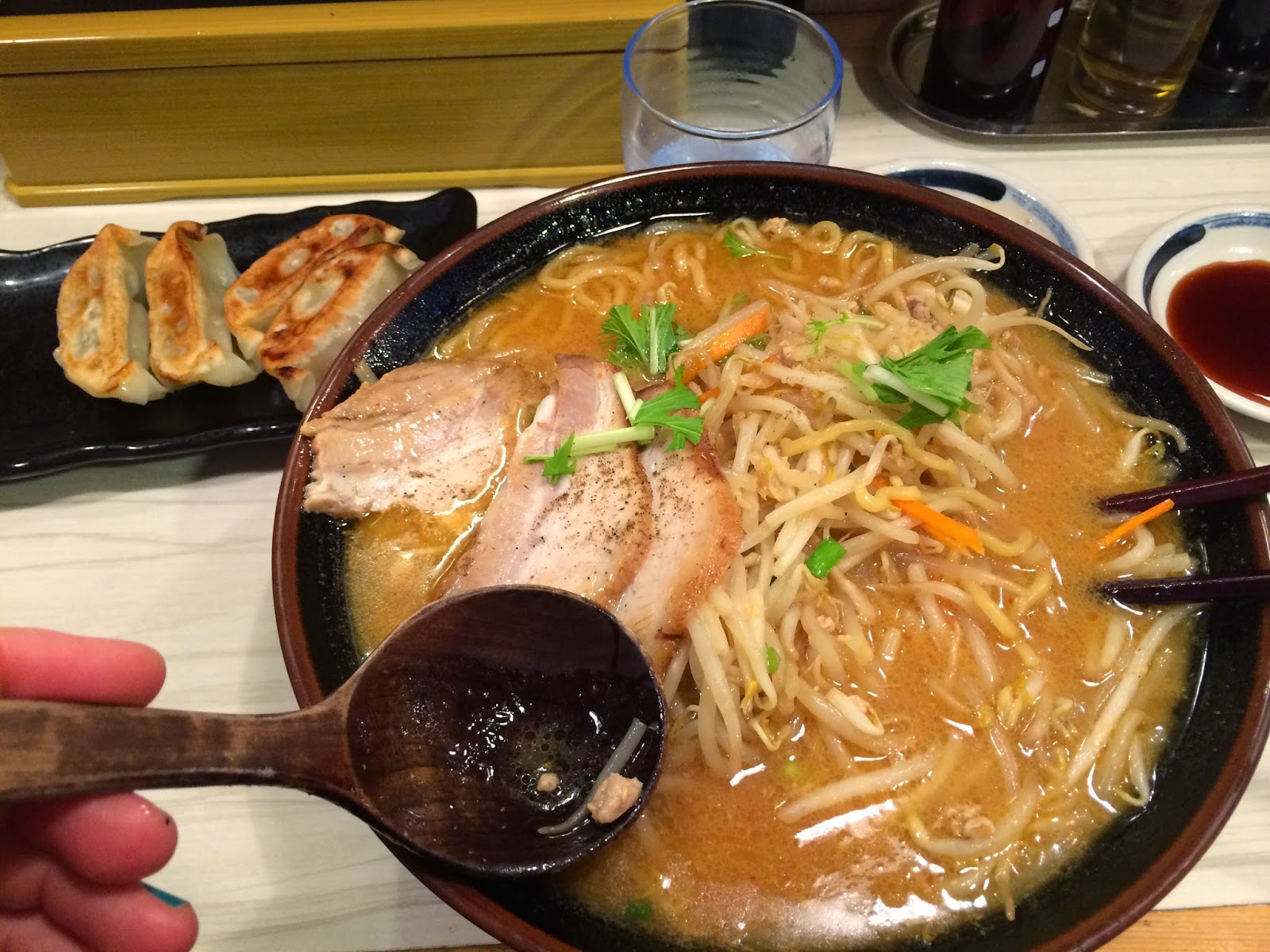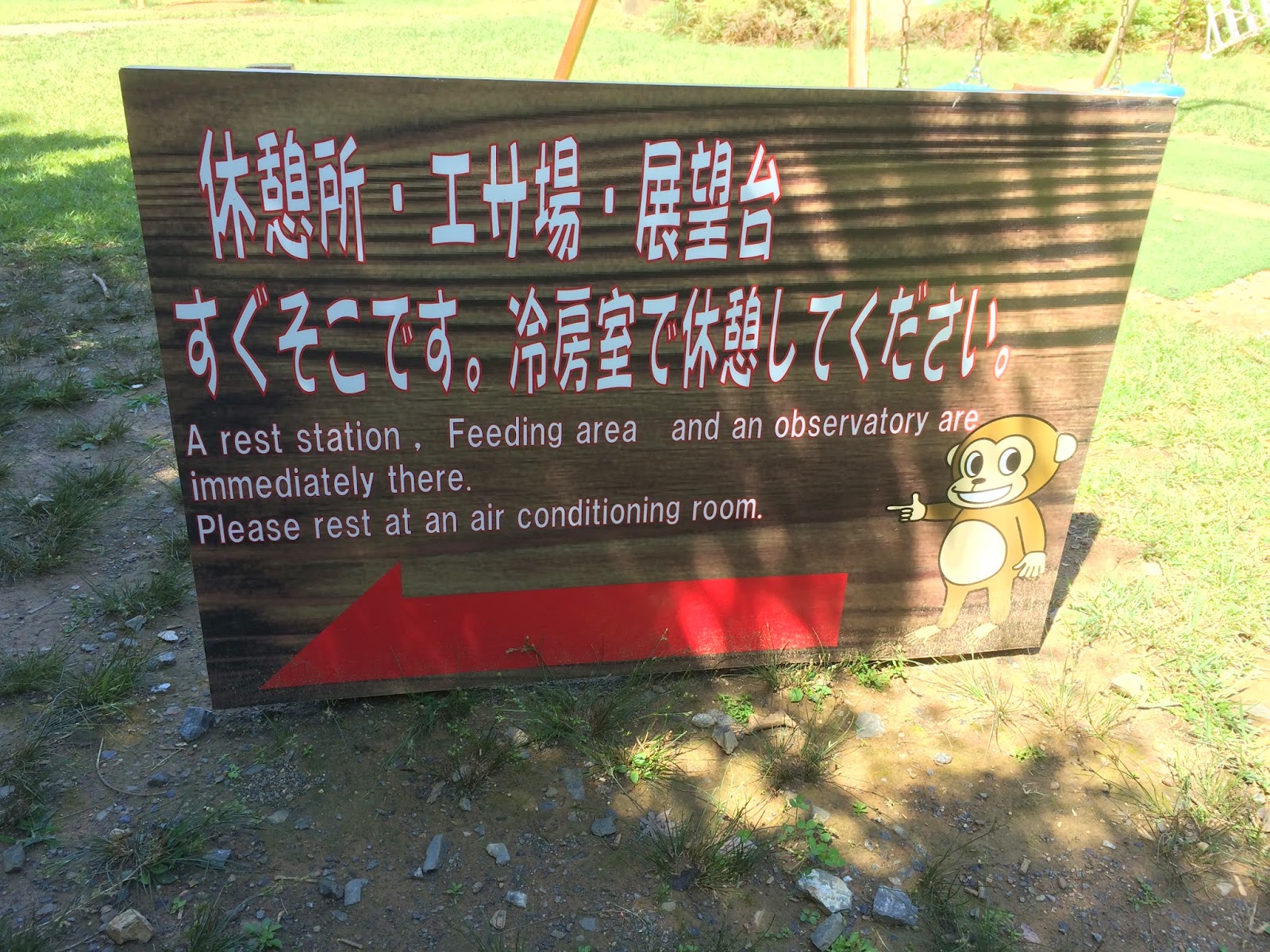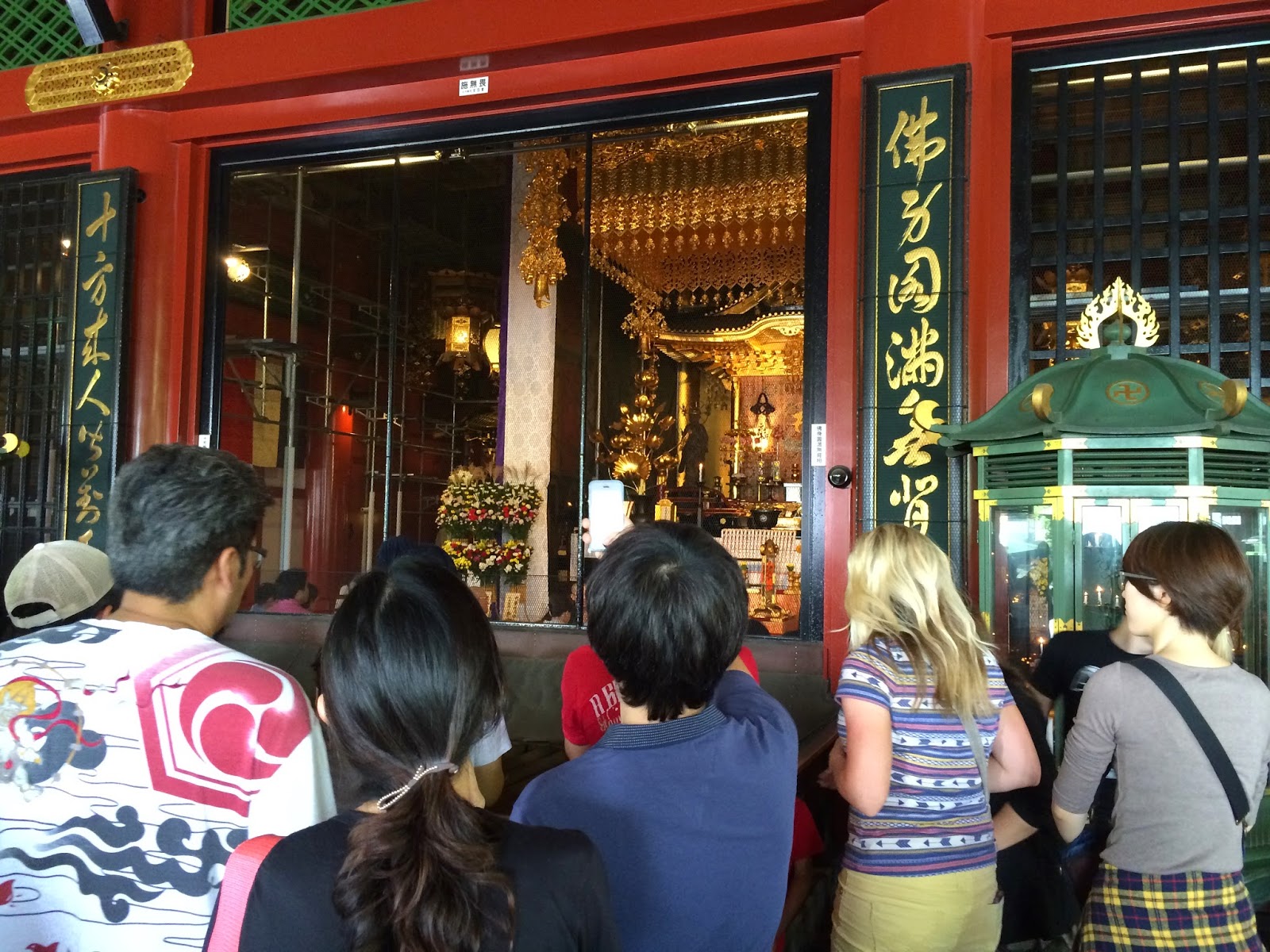When you arrive at Narita Airport, you get a bus, the train or a taxi to come into Tokyo. Because the airport is over an hour away by car from the city, you are looking at spending about $250 for a taxi, so people either take the train or a "limousine bus" into the city. We happen to live next to one of the hotels where one of the limousine buses stop so I was able to walk over and meet Britt and Mike when they arrived. (Kent was in Vienna, Austria the day they got here.) I can't explain how excited I was waiting for that bus to pull in to that hotel. I'm sure that I broke a few of their ribs as I hugged them!
Look at those happy faces after a long, long flight!!
Once they got their things settled in our apartment, we went out for a walk just before we got something to eat at our favorite restaurant.
We saw Tokyo Tower on our walk and then we headed to.....
our favorite Thai restaurant before the jet-laggers headed to bed.
The next day we went on a walk around the neighborhood and couldn't help but see the old verses the new everywhere we looked.
We walked over to see the Zozoji Temple, which is one of the largest and oldest Buddhist sect temples in Tokyo. As we walked up to this incredible entryway, we were greeted by.......
this happy, inviting statue. I think he's telling the evil spirits to back off!! Is he referring to us?
As we walked in through the gate, there happened to be .....
a woman entertaining people with her trick monkey. The monkey was amazing!
Before we got to the temple, this large bell greeted us. The priests ring the bell before certain religious ceremonies take place.
This statue is in remembrance of someone that was associated with the shrine. Since I can't read kanji, a lot of information is left unknown to me, the foreigner.
This is the temple in the background. This picture makes it look smaller than it really is.
When we got up to the temple doors,
Brittney knew exactly what to do from her childhood experience of being raised in Japan.
Here is a picture of the inside of the shrine.
Inside of the shrine grounds, you see thousands of these dolls dressed in special clothing. The closest comparison that I can come to with describing these dolls would be to call them headstones of those who have passed on. Bodies are cremated here so instead of getting a plot of ground like we do in the states, people either "buy/rent" a statue in a shrine or they have a small shrine type statue in a cemetery.
After our visit to the shrine, we walked over to the Tokyo Tower.
We decided to go to the top of the tower and yes, the view was awesome from
the glass bottom floor and from
the top. Looking out over part of the city and out to the bay with our apartment in site was fun to see from so high up.
After our Tokyo Tower experience,
we hopped on the train to go see the Imperial Palace. Nice pose, Mike!
Mike's into posing! Thank you, Mike!
The famous Imperial Palace photo-taking spot! The palace itself is beyond the bridge directly over Brittney and my heads. You can basically only see the outline of the roof.
The happiest place on earth was where we found ourselves the next day.
Tokyo Disneyland.
Are we following Minnie Mouse? Check out that bag!!
Well look! We are in Disneyland with all of the characters.
The characters are every where and thousands of them!
I'll send any of you a postcard from Japan if you can name who any these characters are!
Check out the heels with this costume. How does one wear heels at Disneyland without having to see a podiatrist or a massage therapist the minute you get home?
After we roamed around Disneyland for a while, we figured out that we didn't get the memo to dress up as our favorite Disney character. That is why characters were every where!! We also discovered that the real characters are caucasian and not Japanese. They sure tried fooling us!
I suppose we would have been considered party poopers since we didn't dress up!
But we weren't party poopers when it came to going on all of the rides!
Splash Mountain - one of the greatest rides ever.
Haunted Mansion was decorated for Halloween.
How can you be at Disneyland without eating a turkey leg,.... even if they are $10 apiece! Ugh!!
We ended our night by eating Sukiyaki and Shabu Shabu. Yummy!!!
The next day we went to a place called Kamakura and on our way, I couldn't resist taking this picture.....
FripSide! I for sure want to buy this album!! Wait.......shouldn't it be FlipSide??? I love Japanese English!
Off we went on our Kamakura adventure!
We ran into just a few people on our way.
The trains are the best way to get around Japan.
When we first got to Kamakura, we did the normal wash your hands and purify yourself before you go in to see the Great Buddha. Nice job, Mike!
Here it is! The Great Buddha! Hasn't everyone seen this in your social studies books from school? If you didn't see this, then you must have sluffed class......????
Just some information on the "Daibutsu".
After seeing the Daibutsu, we decided to go on a hike. On our way we, of course, found the normal interesting Japanese fashions.
Twenty-four year old or older women with stuffed animals hooked to back packs, pig tails, lace, frills, thigh socks, and anything cutsie you can find in a store you will find connected to girls of any age. It makes hiking and walking around for us so much more entertaining!
The hike up the mountain had to be cut short since we had a time commitment to get back to Tokyo. Mike's loving the hike and hated to stop. Britt, however, had to make some adjustments after walking for a few miles......
The day is not even half over and rebellion had already started in the feet.
Our next stop in Kamakura was at one of the many famous shrines where Brittney found one of her favorite childhood treats......
Odongo. Pounded mochi rice with a sweet soy sauce on it and.....
her favorite drink, Lamune. She was feeling like she was 8 years old again!
The gardens at the shrine were beautiful!
At the top of the shrine gardens we looked out and saw the ocean, so we decided to go check out the beach!
Mike was the first to rip his socks off and head out to feel the nice cool water,
while Britt was asked to be a photographer. After "frolicking" on the beach for a while, we headed back home to meet Kent for none other,
than a bowl of piping hot miso ramen on a hot day. That makes sense! Uh no....
What makes sense is that when you are only in the country for a short time, you get your favorite food no matter what the temperature is outside. This is what a real bowl of ramen looks like, people. That cup noodle stuff is like I said, stuff. Check out the pot stickers on the side. Move over Costco, your potstickers aren't even in the same category as these are.
Four happy awaiting faces for that yummy bowl of ramen.
Pointer to all of you ramen lovers,......wear your bib or you'll have laundry to do when you get home.
Since food is on our mind, let's head over to a supermarket.
Mike is anxious to devour that fish even though he just ate a gallon of Ramen! Ha! Ha!
The intention was to buy fruit and bread for breakfast, however, that's not what we walked out with. I would suppose we would be accused of being impulse shoppers.
Shopping in Ginza was a must. It's considered Tokyo's "5th Avenue".
Mike had to watch his head in quite a few places. He's considered one of the American giants.
Hello Kitty!?!? Where are Evie, Lilly, and Norah?
Just to show you the size of grapes.... Yes, their taste is bigger than their size.
One of the cheaper melons.....$100 for one melon. I suppose it was raised in a gold or diamond mine. No? So what makes this melon so special? That's the million dollar question.
One of our favorite meals is Tonkatsu or Chickenkatsu so we decided to take Mike and Britt to the world's best Tonkatsu restaurant.
Breaded pork cutlet that melts in your mouth (with no fat), cabbage salad, miso soup, rice, Japanese pickles, and Uzu ice cream for dessert. It is fabulous!
Early the next morning we headed out the door to the airport for a three-day quick trip down south.
Our flight was a bright and early 7:00 a.m. flight out of Tokyo for Hiroshima. Hey! These kids are jet-lagged so waking up at 4:30 a.m. was "cake"!
Check out those bright, smiley faces! Notice everyone else on the plane. They are half asleep!
On this map, you can see in bold print the names of the 5 areas of Japan. Up north is the island of Hokkaido, below that is Hachirogata, then Honshu, Shikoku, and Kyushu. As you can see, Hiroshima is on the southern end of Honshu. We arrived at the airport around 8:30 a.m., went on a bus to the Hiroshima train station, put our bags in a locker, and walked toward the platform to catch a city train to Peace Park.
On our walk to the platform, we saw the funniest sign. No bikes!! We were pretty sure that no one would ever think of taking a bicycle where we were unless they wanted to carry a bicycle up and down stairs and over people.
We love how the Hiroshima trains are much less congested than the Tokyo trains.
It's hard to describe the feeling you have when you are at Peace Park. This is the result of people's desire for power and their hatred toward others. Sad.
This is the Children's Peace Monument where children from all over the world bring 1,000 folded paper cranes in remembrance of Sadako hoping the world will never use another nuclear bomb again. When we were there, we were honored to hear a group of school children pay tribute through song and presenting their paper cranes to those children who were killed so many years ago.
The millions of paper cranes are stored behind the statue in these glass boxes.
Thousands upon thousands of beautiful hand-made paper cranes are on display at this memorial.
When we finished visiting Peace Park, we got on another train headed toward the island of Miyajima.
What is so special about Miyajima? The famous Ituskushima Shrine is there.
Itsukushima Shrine
| Itsukushima Shinto Shrine | |
|---|---|
| Name as inscribed on the World Heritage List | |
 | |
| Itsukushima Shrine (Japanese: 厳島神社 Itsukushima-jinja) is a Shintoshrine on the island of Itsukushima (popularly known as Miyajima), best known for its "floating" torii gate.[1] It is in the city of Hatsukaichi in Hiroshima Prefecture in Japan. The shrine complex is listed as a UNESCOWorld Heritage Site, and the Japanese government has designated several buildings and possessions as National Treasures. | |
History
The shrine has been destroyed many times, but the first shrine buildings were probably erected in the 6th century. The present shrine dates from the mid-16th century, and is believed to follow an earlier design from the 12th century.[3] That design was established in 1168, when funds were provided by the warlord Taira no Kiyomori.
The shrine was designed and built on pier-like structures over the bay so that it would appear to be floating on the water, separate from the sacred island, which could be approached by the devout.
Near the main shrine is a noh stage which dates from 1590.[1] Noh theater performances have long been used to pay homage to the gods through the ritual acting out of key events in Shinto myth.
The dramatic gate, or torii, of Itsukushima Shrine is one of Japan's most popular tourist attractions, and the most recognizable and celebrated feature of the Itsukushima shrine,[4] and the view of the gate in front of the island's Mount Misen is classified as one of the Three Views of Japan (along with the sand bar Amanohashidate, and Matsushima Bay). Although a gate has been in place since 1168, the current gate dates back only to 1875.[1] The gate, built of decay-resistant camphor wood, is about 16 metres high. The placement of an additional leg in front of and behind each main pillar identifies the torii as reflecting the style of Ryōbu Shintō (dual Shinto), a medieval school of esoteric Japanese Buddhism associated with the Shingon Sect.
The torii appears to be floating only at high tide. When the tide is low, it is approachable by foot from the island. Gathering shellfish near the gate is also popular at low tide. Many locals add the shellfish they gather to their miso soup. At night, powerful lights on the shore illuminate the torii.
On September 5, 2004, the shrine was severely damaged by Typhoon Songda. The boardwalks and roof were partially destroyed, and the shrine was temporarily closed for repairs.
Religious significance
The shrine is dedicated to the three daughters of Susano-o no Mikoto, Shinto god of seas and storms, and brother of the sun goddess Amaterasu (tutelary deity of the Imperial Household). Because the island itself has been considered sacred, commoners were not allowed to set foot on it throughout much of its history to maintain its purity. To allow pilgrims to approach, the shrine was built like a pier over the water, so that it appeared to float, separate from the land.[5] The red entrance gate, or torii, was built over the water for much the same reason. Commoners had to steer their boats through the torii before approaching the shrine.
Retaining the purity of the shrine is so important that since 1878, no deaths or births have been permitted near it.[6] To this day, pregnant women are supposed to retreat to the mainland as the day of delivery approaches, as are the terminally ill or the very elderly whose passing has become imminent. Burials on the island are forbidden.
In order to get to Miyajima, you have to ride a boat.
And who are these people? Throw them overboard!! They're lunatics!
There it is! Itsukushima Shrine off in the distance!
When we landed on the island, we were hungry, so as we were walking toward the shrine, we stopped at a restaurant and look who greeted us!
A deer!?! A wild, tame deer who wanted to come in for lunch! The people treat them like they would their pet dog.
Mike was trying to coax the deer to come in and have lunch with him!
Once we finished lunch, we continued on our walk towards the shrine.
As you can see, it was a low tide.
The normal ritual of washing your hands before you enter was performed by all.
Enjoy the pictures!
We witnessed a wedding ceremony while we were there. The bride is in the white gown.
This guy was trying to convince Kent to spend $100 to have him pull us on a jin riku sha. Unfortunately for him, he didn't convince Kent.
Lovely.......
To the right as you can see is a beautiful pagoda and on the left is another shrine that was built hundreds of years ago.
We decided to hike up and check these out.
In order to appreciate this building, I had to blow it up larger than the other pictures. It is so amazing.
Inside the shrine are incredibly old beautiful paintings on display in the rafters, which depict an ancient era of time.
The wooden floor was the softest wood floor I have ever walked on. It reminded me of touching silk.
As we were at the end of our time at Istukushima, we noticed........
how the tide had arisen.
We headed back to Hiroshima and got on the Shinkansen (Bullet Train) and went to Kyoto for the night and stayed at a "Minshuku" or Japanese style bed and breakfast called Chitose.
It was so cute!
We arrived around 8:00 p.m. and were hungry, so we stopped at a local grocery store and picked up some things to eat. Mike and Britt feel right at home sitting at their kotatsu (table) on the zabuton (cushion) on top of the tatami mat (woven straw mats as the flooring) eating with their ohashi (chopsticks). Mike, you are a pro!!
Once we finished eating, we moved the table and got their beds called Futons out.
Here is a modified tour of the minshuku (bread and breakfast).
Here is the entry way view from the front door looking in to the home,
and this is in the hallway looking toward the front door.
This is the upstairs bedroom area where there are 4 bedrooms.
This is a toilet room and vanity (there are two vanities, 3 toilet rooms, and two ofudos (Japanese style shower/bath in this minshuku). By the way, don't ever walk out of the bathroom with the bathroom slippers on. They stay put!
It's time for bed and a yukata (Japanese style pajamas) is provided for each of the guests. Wow! Cool!
Nice, Britt! Good night!
The next morning, we are served breakfast at 7:30 a.m.
and Dad is ready for this incredible breakfast!
Mike and Britt were just as excited to see what the surprise breakfast would be. Let's get a closer view!
Lotus root, tofu, pickles, the best melon I have ever had,
miso soup, flavored-cooked vegetables,
surprisingly tasty little fishies.
and delicious salmon, egg, a grilled pepper, a kind of tofu, and another kind of Japanese food.
And, of course, rice! Any of you lactose or gluten intolerant people should move here and eat the traditional Japanese food. No dairy or wheat here!
After we finished breakfast, we headed out to catch a train to the outskirts of Kyoto to a place called:
Arashiyama
Arashiyama (嵐山 Storm Mountain?) is a district on the western outskirts of Kyoto, Japan. It also refers to the mountain across the Ōi River, which forms a backdrop to the district. Arashiyama is a nationally-designated Historic Site and Place of Scenic Beauty.[1]
Notable tourist sites[edit]
- The Iwatayama Monkey Park on the slopes of Arashiyama. Over 170 monkeys live at the park. While the monkeys are wild, they have become accustomed to humans. The park is located on a small mountain not far from the Saga-Arashiyama rail station. Visitors can approach and photograph the monkeys. At the summit is a fenced enclosure, from within which visitors can feed the monkeys.
- The romantic "Moon Crossing Bridge" (渡月橋,Togetsukyō), notable for its views of cherry blossoms and autumn colors on the slopes of Arashiyama.
- The tombstone of the Heike courtesan Kogo of Sagano.
- Tenryū-ji, the main temple of one of the 15 branches of the Rinzai school, one of the two main sects of Zen Buddhism in Japan.
- The hamlet of Kiyotaki, a small scenic village at the base of Mt Atago, the home to a notable Shinto shrine.
- Matsunoo-taisha, a shrine half a mile south of the area, which is home to a blessed spring. It is also one of the oldest shrines in the Kyoto area, founded in 700. The alleged restorative properties of the spring bring many local sake and misocompanies to the shrine for prayers that their product will be blessed.
To make our Arashiyama adventure more adventurous, we rented bikes!
Here we are on the bridge at the Oi River next to Mount Arashi or in Japanese terms "Arashiyama".
The hike was beautiful.
Instructions along the way...
I wonder if they pick fleas off of humans?
Inside the building is where we were able to feed the monkeys. It was so fun!
Mike tried tricking one of the monkeys with an empty peanut shell. You should have seen the cursing that Mike got from the monkey. It was so funny!
This view is looking out over Kyoto.
The monkeys have a hierarchy where the older ones get first dibs on food, and the younger ones are intimidated by them.
Once we finished hanging out with the monkeys, we hiked back down the mountain, got on our bikes and road through town to the bamboo forest.
The bamboo forest was amazing.
On our way back to our minchku to meet Kent for dinner, we walked by this Kabuki theater.
Notice the person in the window. It's a Kabuki actor.
What is Kabuki?
Kabuki (歌舞伎?) is a classical Japanese dance-drama. Kabuki theatre is known for the stylization of its drama and for the elaborate make-up worn by some of its performers.
Once we met Kent, we went into a popular area of Kyoto where many great restaurants are to meet Brittney's long-time childhood best friend, Hiroko. This area is called Pontocho.
The anticipation to see Hiroko was so exciting!
Kent and I were anxiously waiting to see her too!
It was so fun for these two women, who were once childhood best friends, to embrace each other after so many years.
We found the best one-room restaurant! It literally is one room where you sit at the counter on one side and he cooked on the other side.We felt like we were sitting in the chef's own kitchen as we watched him cook anything we wanted to eat.
Kent had to go through the bathroom to get to the kitchen to take this picture with the chef.
He we are with happy faces eating the most fabulous food!
The next day took us up the road from our minchku to a famous Buddhist temple called Kiyiomizudera. We saw some great things along the way such as.....
smaller unique temples or shrines and
interesting homes/gates along the way. An artist lives in the home behind this gate where he has paper mache masks displayed.
This monk in training was standing by the entrance.
You may have noticed the brown "walls" in some of the pictures. The brown walls cover the actual building as it is being remodeled.
A Buddhist monk.
You must take off your shoes before going into the temple.
People praying......
Here is one of the shrines that people pray at.
Looking down from where we were at the people wanting to be blessed by the holy water.
The temple grounds were beautiful.
The detail of the ancient buildings are so amazing.
This particular soffit reminds me of how the Koreans paint their soffits.
The roads leading to and from the temple are like Park City, Utah on steroids. Every kind of shop that you can think of exists on these roads with thousands of people milling around looking and buying.
This shop is a soap shop that lets you test the soap out. The cool thing about this soap shop is that the soap feels like jello.
This is classic.
And so is this......
This guy was happy with us since we bought snacks from his shop.
This picture is exactly what you want to see when you are in Kyoto.
We stopped at one of the shops to try a Peruvian empanada! In Kyoto? Yes! A Japanese man who owned the store married a Peruvian woman who made empanadas for the customers. It was great!
These smiling faces are the result of another great day!
The next day we checked out of the minchku, went to the train station, put our bags in a locker and then headed to a place called Fushimi Inari to see another famous shrine.
Well, let's check out this popular place!
Fushimi Inari Shrine
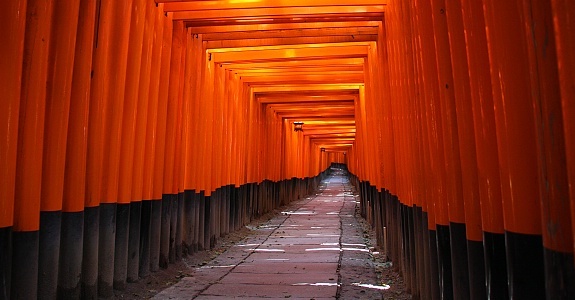 A walking path leads through a tunnel of torii gates
A walking path leads through a tunnel of torii gates
Fushimi Inari Shrine (伏見稲荷大社, Fushimi Inari Taisha) is an important Shinto shrine in southern Kyoto. It is famous for its thousands of vermilion torii gates, which straddle a network of trails behind its main buildings. The trails lead into the wooded forest of the sacred Mount Inari, which stands at 233 meters and belongs to the shrine grounds.
Fushimi Inari is the most important of several thousands of shrines dedicated to Inari, the Shinto god of rice. Foxes are thought to be Inari's messengers, resulting in many fox statues across the shrine grounds. Fushimi Inari Shrine has ancient origins, predating the capital's move to Kyoto in 794.
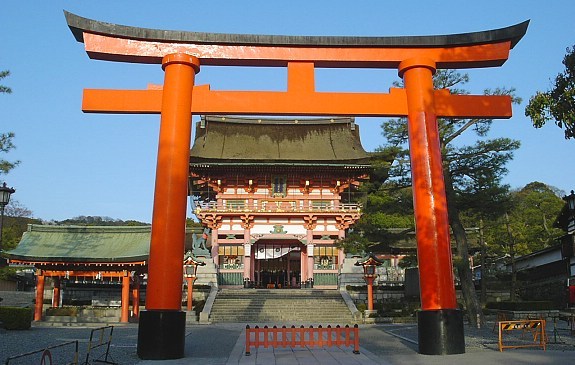
While the primary reason most foreign visitors come to Fushimi Inari Shrine is to explore the mountain trails, the shrine buildings themselves are also attractive and worth a visit. At the shrine's entrance stands the Romon Gate, which was donated in 1589 by the famous leader Toyotomi Hideyoshi. Behind stands the shrine's main building (Honden) and various auxiliary buildings.
At the very back of the shrine's main grounds is the entrance to the torii gate covered hiking trail, which starts with two dense, parallel rows of gates called Senbon Torii ("thousands of torii gates"). The torii gates along the entire trail are donations by individuals and companies, and you will find the donator's name and the date of the donation inscribed on the back of each gate. The cost starts around 400,000 yen for a small sized gate and increases to over one million yen for a large gate.

The hike to the summit of the mountain and back takes about 2-3 hours, however, visitors are free to walk just as far as they wish before turning back. Along the way, there are multiple smaller shrines with stacks of miniature torii gates that were donated by visitors with smaller budgets. There are also a few restaurants along the way, which offer locally themed dishes such as Inari Sushi and Kitsune Udon ("Fox Udon"), both featuring pieces of aburaage (fried tofu), said to be a favorite food of foxes.
After about a 30-45 minute ascent and a gradual decrease in the density of torii gates, visitors will reach the Yotsutsuji intersection roughly half way up the mountain, where some nice views over Kyoto can be enjoyed, and the trail splits into a circular route to the summit. Many hikers only venture as far as here, as the trails do not offer much variation beyond this point and the gate density decreases further.
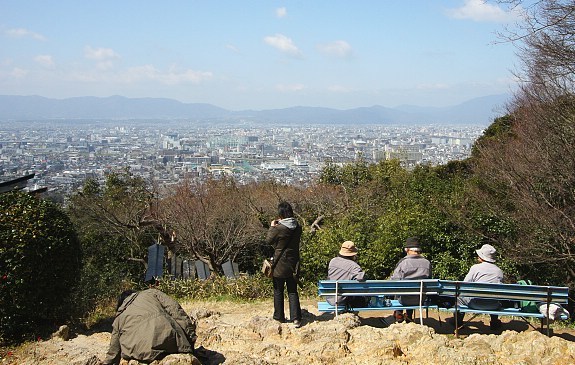
Numerous people wanted their picture taken with Kent when they recognized him. So funny!
After our hike on the mountain, we stopped and bought an inari sushi. What's that?
Inarizushi[edit]
| Wikibooks Cookbook has a recipe/module on |
Inarizushi (稲荷寿司) is a pouch of fried tofutypically filled with sushi rice alone. It is named after the Shinto god Inari, who is believed to have a fondness for fried tofu. The pouch is normally fashioned as deep-fried tofu (油揚げ, abura age).
Inarizushi is so yummy!!
Next we came to a store where they make homemade.....
senbei or rice crackers. These all have various spices or soy sauce on them.
Back to the train station we went.....
and on to the Bullet train (Shinkansen) to return to Tokyo.
As we were waiting for our train, we saw this adorable mom carrying her two kids. Her core strength is amazing!!
So we passed a pie store that was selling the most delectable fresh made pies in the entire world!! Marie Calendars, move over! You ain't got a chance. We broke down and bought one piece which was a mere $10. We each had a $2 bite but it was worth it!! A custard, cream pie with fresh fruit. Yummy!
The seats on the shinkansen were very comfortable. Notice the white cloths on the heads of the seats. They change them regularly. Yes, they think of lice and nasty germs that rub on the seats from various people's heads. Why don't we in the U.S.? So nice!
This is a shot of our last leg of the trip......going up the stairs from the subway station to our apartment. Britt had to get a shot of Dad on his phone.......
Hey Mike, you are half way there. Don't stop now! We still have places to go and people to see today and it's 6:00 p.m. There's not much time in the day left! You can do it! We know you can!
The place we had to go was Shibuya and the people we had to see were millions.
This is only a small part of Shibuya. It is one of the "hot spots" of Tokyo for young people.
This is a famous statue. Does anyone know what it is?
It is:
Hachiko Square (sometimes called Hachiko Plaza) is perhaps the busiest and best-known meeting place in Tokyo. Named in honour of the famous statue of “Faithful Dog Hachiko,” (忠犬ハチ公 ), it is fenced in by a department store, two train stations and the well-known Shibuya pedestrian scramble crossing that is said to be the busiest in the world.
This plaza is usually teeming with people, especially during the evenings and on weekends. Even though there are no benches to sit on and only a few metal railings to rest against, it is considered a prime people-watching spot and a very popular meeting place. Most people, locals and tourists alike, gravitate toward the statue, a bronzed Akita Inu, referred to as Hachi or Hachiko (sometimes Chuuken Hachiko, or “Faithful Hachiko"). The original statue was erected in 1934 to honour the dog, who met his master, Professor Ueno Hidesaburo, every day at the station after work. When Professor Ueno died in 1925 and did not return, Hachiko continued to wait for him daily for the next nine years, appearing exactly when the train was due.
Hachiko’s story gained attention, and his loyalty was renowned. He died of cancer and a filarial infection the year after the statue was unveiled, but his story has continued to be told and the 2.4 million people who use Shibuya Station pass by the bronze dog each day.
The Square has few features aside from Hachiko. The main Shibuya police box is to the south, adjacent to the JR Shibuya Station Hachiko Exit. Directly to the northeast is the famous scramble crossing that has been featured in many movies, such as Lost In Translation. In the center of the square you’ll find an old-fashioned Setagaya Line train car that serves as a small museum.
Under the bright city night lights!
In our milling around Shibuya, we went to another food place. Really? I'm pretty sure we each put away 10,000 calories a day around here! It's a good thing we are putting on 10 miles a day on foot to wear those calories off! We had to go eat another ramen before Mike and Britt returned to the states. This is a soy sauce based ramen with pork roast and veggies in it. So good!!
Yes, we have smiles on our faces again...!!!
Were we finished eating after the ramen? No way!
Dessert time!
We went to the Cerulean Tower Hotel in Shibuya and had these tasty little morsels. One is a shoux creme' or in our good ol U.S.A. terms, cream puff. Ok, people, this does not even come close to our cream puffs. A french pastry chef has perfected the art of making these shoux creme's and you can not imagine how delicious they are. The other two desserts are called, citrus tarts which are impossible to explain the mouth watering affect they have on you. If you have never tasted them, you can not imagine how good they are. It's just that difficult. How do you explain the taste of salt? Now you know what I mean? Ya, hard.
Nope, we aren't done eating yet! Mr. Bean received a visit from us. This is one of Rachelle's favorite places in Shibuya.
A warm custard filled cakey, round dessert.
Let's head back out into the crowds.....
and head down to see more food. The Food Show in the basement of the Tokyu Department Store.
I have posted pictures from our Food Show adventures in previous posts, but here are a few pictures that I can refuse.
This is an Italian food booth where they make a particular pasta dish that they put hot pasta in this huge cheese bowl. By doing this, the hot pasta melts the cheese onto the pasta which makes for a tasty pasta dish.
We are looking at bakers baking the most delectable desserts while
wearing their white, sterile attire. Everything is immaculately clean here. Love it!
How about buying a grape plant for $150?
Let's call it a night and head home to bed. It has been a big day!
The next day was Sunday, so after church, we walked partially home and enjoyed a walk through Arisugawa Park.
After returning home to change our clothes, we got on a train and went to the part of the city where Brittney grew up. The town is called Naruse which is in the city limits of Machida, which is part of Tokyo. (Tokyo is a big place...)
This is the 4-plex where we lived when she was a baby. This is where she met her best friend, Hiroko, whom we saw in Kyoto. We lived on the 2nd floor and Hiroko's family lived below us. We have great memories here.
Our door on top, and Hiroko's door below.
Britt and her friends use to sit on this wall when they were out playing.
Good times! Great childhood memories!
After we checked out our apartment, we went to our dear friends' home for a neighborhood reunion. There were 4 families who became good friends as we raised our children. The Kinoshita family who lived directly below us, the Sakaki family who lived kitty corner below us, and the Iishikawa family who lived in the next building. Since we have all moved away from Royal Town, the Ishikawa family invited us to their home for a get together.
It was so fun for Brittney to see her Japanese families! This is the Kinoshitas. The mom, Etsuko with one of her daughters, Naoko, and Naoko's baby. The rest of the family couldn't come. Hiroko was in Osaka and Masaji was out of the country. "Daddy" Kinoshita could not come.
Brittney had to get some squeezes from Naoko's baby boy, Hajime. So cute!!
This is part of the Sakaki family; Mai and Kogo.
Mizuyo Ishikawa put on the most incredible spread. She had to be cooking for days before we got there. She is a fabulous cook and her meal was so appreciated.
Mizuyo is on the right in the white shirt next to her husband.
She showed us some old pictures from when we lived in Naruse. Dad's sister, Celeste, happened to be visiting us when this picture was taken. Oh, the good ol' days! Love the hair. Mizuyo was the only one with timeless hair. Celeste and I had to be trendy and boofy!
Brittney with Tsugukun Ishikawa.
Rachelle with Tsugukun.
Brittney, Tsugukun and two other boys that I don't recognize.
We now will show our group shots.
Kinoshita family.
Sakaki family.
Ishikawa family.
On Monday we went to the peaceful Hamarikyu Gardens.
At the end of our tour of the gardens, we got on a boat which took us up the river for some sight seeing and then dropped us off in Asakusa.
We went to Asakusa to see the famous Sensoji temple.
Sensoji Temple
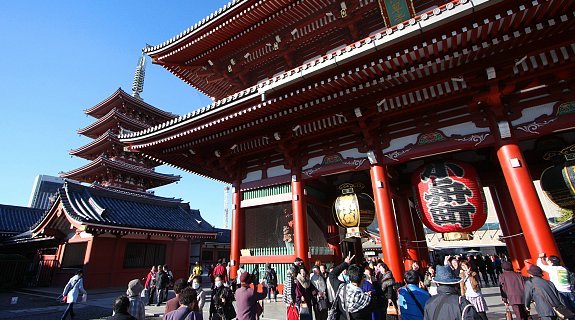
Sensoji (浅草寺, Sensōji, also known as Asakusa Kannon Temple) is a Buddhist temple located in Asakusa. It is one of Tokyo's most colorful and popular temples.
The legend says that in the year 628, two brothers fished a statue of Kannon, the goddess of mercy, out of the Sumida River, and even though they put the statue back into the river, it always returned to them. Consequently, Sensoji was built nearby for the goddess of Kannon. The templewas completed in 645, making it Tokyo's oldest temple.
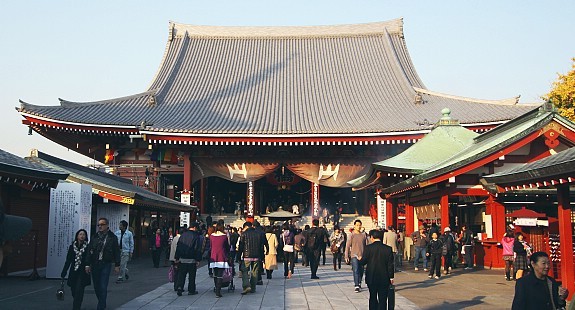
When approaching the temple, visitors first enter through the Kaminarimon (Thunder Gate), the outer gate of Sensoji Temple and the symbol of Asakusa and the entire city of Tokyo.
A shopping street of over 200 meters, called Nakamise, leads from the outer gate to the temple's second gate, the Hozomon. Alongside typical Japanese souvenirs such as yukata and folding fans, various traditional local snacks from the Asakusa area are sold along the Nakamise. The shopping street has a history of several centuries.
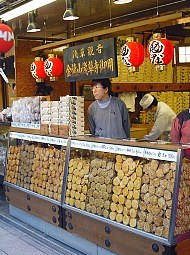 | 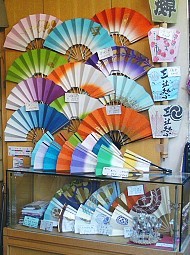 | 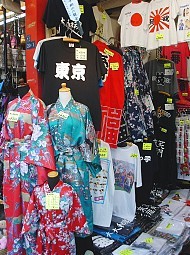 |
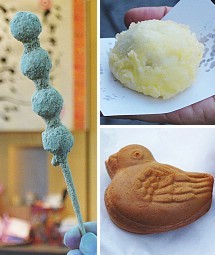 | 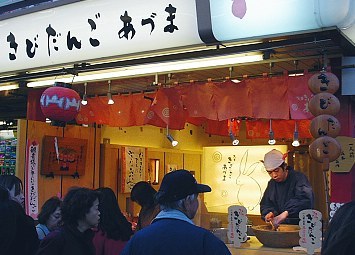 |
| Clockwise from top left: Kibidango (skewered rice flower dumpling covered with soybean powder), Agemanju (battered and deep fried soft cake filled with red bean paste), Kibidango Shop, Ningyoyaki (cake with red bean paste filling) |
Beyond the Hozomon Gate stands the temple's main hall and a five storied pagoda. Destroyed in the war, the buildings are relatively recent reconstructions. The Asakusa Shrine, built in the year 1649 by Tokugawa Iemitsu, stands only a few dozen meters to the left of the temple's main building.
Various events are held throughout the year in the Sensoji Temple area. The biggest of them is the Sanja Matsuri, the annual festival of the Asakusa Shrine, held in May. Other events are the Asakusa Samba Carnival in August and the Hagoita-ichi (Hagoita Market) at which decorated wooden paddles used in the traditional game of hanetsuki are sold.
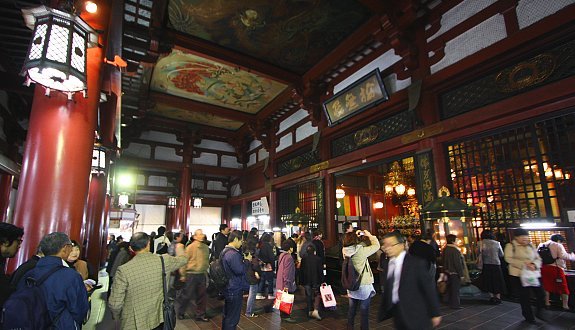
People, people everywhere!
Eating again and........
again!
After our adventure in Asakusa, we went to........
Ginza
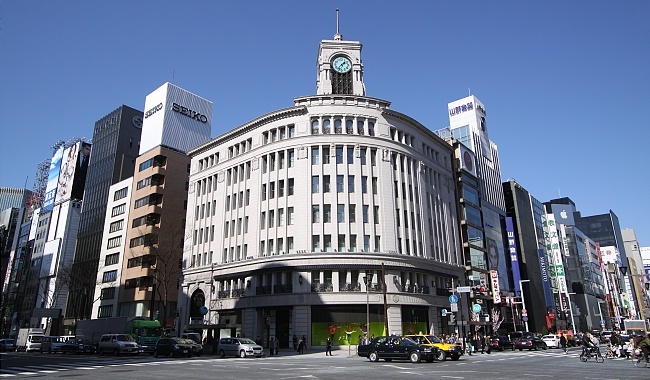
The Ginza (銀座) is Tokyo's most famous upmarket shopping, dining and entertainment district, featuring numerous department stores, boutiques, art galleries, restaurants, night clubs and cafes.
One square meter of land in the district's center is worth over ten million yen, making it one of the most expensive real estate in Japan. It is where you can find the infamous $10 cups of coffee and where virtually every leading brand name in fashion and cosmetics has a presence.
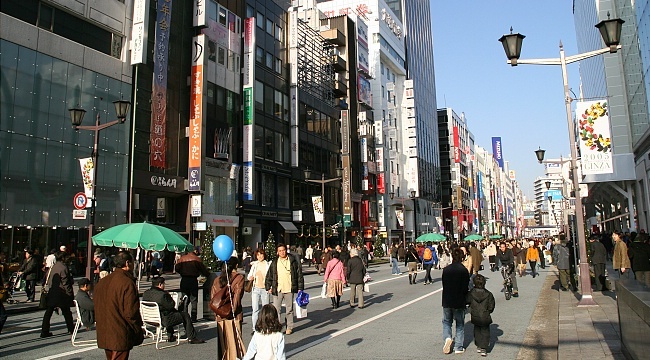
From 1612 to 1800, today's Ginza district was the site of a silver coin mint (Ginza means "silver mint" in Japanese), after which the district was eventually named. The Ginza evolved as an upmarket shopping district following the 1923 Great Kanto Earthquake.
Most shops in the Ginza district are open every day of the week. A visit is most pleasant on weekend afternoons when the central Chuo Dori street is closed to automobile traffic and become a large pedestrian zone. The road closure takes place from 12:00 to 17:00 (until 18:00 from April through September).
Now that you know about Ginza, I'm thinking that Mike could do a great job modeling for Dior! Move over sissy!
Britt, I think you could be up on that billboard too!
We love it when the street shuts down to cars on weekends and holidays. Today was a holiday.
After our "shopping" spree in Ginza (Wait, we didn't buy anything... except for maybe food!), we came back to the apartment and went to another one of our favorite restaurants. Cabot Cafe. They make incredible Italian cuisine.
We came back to the apartment after our meal, and we had a special visitor come over. Kazutoshi Sakaki. He and Brittney grew up together at Royal Town. He wasn't able to come meet with us when we were with his family and the other friends, so he stopped by to see Britt and Mike. It was so fun to see him and Britt interact after so many years.
Kazutoshi approved of Mike for Britt. That's a good thing! Lifelong friends.....
The next day was the day Mike and Britt had to go back home after almost 2 fun-filled weeks in Japan.
The last picture in our apartment....
The last picture in the elevator.....
The last picture just before getting on the bus to go to the airport.
Our time spent together will forever be cherished. Thank you, kids, for making the sacrifice to come to Japan while we are here. We had a great time showing you around, and we hope that you enjoyed your trip.
We love you!
Mom and Dad



























































